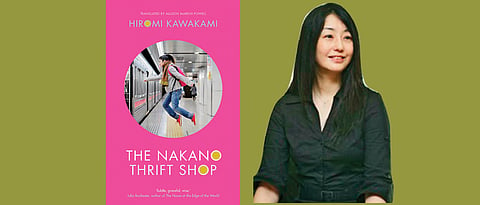

The book with a pretty pink cover and the image of a girl poised in mid-flight on what seems like a suburban train station is what the friendly bookstore owner recommended. I took it because I wanted to read something different than what I usually gravitate towards. The Nakano Thrift Shop turned out to be just that. An entirely different way of seeing, imagining, talking and well, living. Written originally in Japanese by Hiromi Kawakami, who I read on the cover, authored the bestseller Strange Weather in Tokyo, is actually one of Japan’s popular contemporary novelists.
Also, it was February the official month of love and the blurb promised a story about finding love in unlikely places, here in a place called the Nakano Thrift Shop. The book and the shop is populated with four principal characters who can be safely termed eccentric. Mr Nakano for the past 25 years is running the shop in a Western suburb of Tokyo that is full of students. He tells Hitomi, as he interviews her for a job of a part-time help, that he does not sell antiques but “second-hand goods.” With his beard and knitted hat, the shopkeeper made an odd impression on Hitomi, who is the narrator.
The shop is literally overflowing with items ranging from Japanese style dining tables to old electric fans, from air conditioners to table ware and crammed with the kind of items found in a typical household from the 1960s.
The shop is not extraordinary, nor are the oddball cast of customers who troop into it to buy things like old eyeglasses, billed as the sleeper bestseller in the shop. On closer scrutiny the staff as well as its customers are like a bundle of tales with secrets held close to their hearts.
Nakano with his compulsive mannerisms and secretive love life is a source of amusement to the other characters. He is on his third marriage and has three children and he has lovers whom he refers to as the “Bank.” Masayo, Nakano’s sister a spinster in her mid-fifties is artistically inclined and puts up shows of her works. It could one day be an exhibition of fabric dyed with leaves gathered from a forest, or on another day a show on dolls. It is to Masayo that Hitomi goes to for advice after she realises that she is falling for her co-worker Takeo.
Hitomi, forever restless and curious, finds Takeo with his abrupt and taciturn manner disarming. She goes through the awkward stages of love with Takeo which she narrates through the accounts of day-to-day happenings in the store. There is an undercurrent of sexual tension in the book, starting with the clandestine love affairs of Nakamo, particularly one with bookstore owner Sakiko. Masayo takes herself a lover who is younger than her. There are references to Japan’s “love hotels” and also Hitomi’s own discoveries. Japanese society, as we see is a long way off, from its traditional family units with people living increasingly isolated and alienated lives.
The author manages to evoke in us a feeling of loss as Hitomi leaves the shop to go work in a regular office. Finally, while some might be put off by its pace, the book offers a different perspective to love through the characters of the eccentric family living out their lives in the Nakano thrift shop. The story has been translated into English by Allison Markin Powell. The Nakano Thrift Shop is available at the Portobellobooks.com and there is an audio book too.
